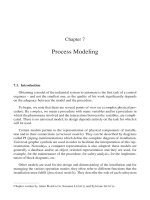Lecture Building reliable component-based systems - Chapter 7: Role-based component engineering
Bạn đang xem bản rút gọn của tài liệu. Xem và tải ngay bản đầy đủ của tài liệu tại đây (273.42 KB, 28 trang )
Chapter 7
Role-Based Component Engineering
Building Reliable Componentbased
Overview
Role-based components
Motivating the use of roles
Role technology
Frameworks and roles
Building Reliable Componentbased
Role-based Components
Focusing on the following aspects of object-oriented
components:
The interface
The size or granularity
Encapsulation
Composition mechanisms
Building Reliable Componentbased
Components
The interface of a component defines the syntax of how
to use a component. The semantics of the interface are
usually implicit.
Reusability
Plug-ability
Building Reliable Componentbased
Concept of Roles
Components may have several different uses in a
system that are dependent on the different roles a
component can play in the various component
collaborations in the system.
With role-based components is that the public interface
is separated into smaller interfaces, which model these
different roles.
Building Reliable Componentbased
Kemerer and Chidamber’s Six Metrics
WMC: Weighted Methods per Class
DIT: Depth of Inheritance Tree
NOC: Number Of Children
CBO: Coupling Between Object classes
RFC: Response For a Class
LCOM: Lack of COhesiveness in Methods
Building Reliable Componentbased
WMC - Weighted Methods per Class
In terms of classes:
This metric reflects the notion that a complex class has
a larger influence on its subclasses than a small class.
In terms of roles:
Roles model only a small part of a class interface.
The amount of WMC of a role is typically less than that
of a class.
Components are accessed using the role interfaces.
A smaller part of the interface must be understood than
when the same component is addressed using its full
interface.
Building Reliable Componentbased
DIT - Depth of Inheritance Tree
In terms of classes:
This metric reflects the notion that a deep inheritance
hierarchy constitutes a more complex design.
In terms of roles:
The DIT value will increase since inheritance is the
mechanism for imposing roles on a component.
It should be noted however that roles only define the
interface, not the implementation.
Thus while the DIT increases, the distribution of
implementation throughout the inheritance hierarchy is
not affected.
Building Reliable Componentbased
NOC - Number Of Children
In terms of classes:
This metric reflects the notion that classes with many
subclasses are important classes in a design.
In terms of roles:
Since role interfaces are typically located at the top of
the hierarchy, the NOC metric will typically be high.
In a conventional class hierarchy, a high NOC for a
class expresses that that class is important in the
hierarchy.
Similarly, roles with a high NOC are important and have
a high cohesiveness value.
Building Reliable Componentbased
CBO - Coupling Between Object classes
In terms of classes:
This reflects that excessive coupling inhibits reuse and
that limiting the number of relations between classes
helps to increase their reuse potential.
In terms of roles:
The CBO metric will decrease since implementation
dependencies can be avoided by only referring to role
interfaces rather than by using classes as types.
Building Reliable Componentbased
RFC - Response For a Class
In terms of classes:
This metric measures the number of methods, which
can be executed in response to a message.
In terms of roles:
Since roles do not provide any implementation, the RFC
value will not increase in implementation classes.
It may even decrease because class inheritance will be
necessary to inherit implementation only, interfaces no
longer.
Building Reliable Componentbased
LCOM - Lack of COhesiveness in Methods
In terms of classes:
This metric reflects the notion that non-cohesive classes
should probably be separated into two classes and that
classes with a low degree of cohesiveness are more
complex.
In terms of roles:
Roles typically are very cohesive in the sense that the
methods for a particular role are closely related and
roles will thus, typically, have a lower LCOM value.
Building Reliable Componentbased
Transformation Conclusions
Roles reduce complexity (improvement in CBO, RFC
and LCOM metrics).
Roles increase complexity in the upper half of the
inheritance hierarchy (Higher DIT and NOC values).
Building Reliable Componentbased
Role Technology
Using roles at the design level
Using roles at the implementation level
Building Reliable Componentbased
Using Roles at the Design Level
Reenskaug proposes an extension to UML:
General way to express object collaborations
Not too general (class diagrams)
Not too specific (object diagrams)
Uses classifier -roles to denote the position an object
holds in an object structure.
Building Reliable Componentbased
Catalysis
Catalysis:
Is a very extensive methodology based on UML, using
the concepts of frameworks to model component
interactions.
It includes a notion of types and type models.
A type corresponds to a role.
A type model describes typical collaborations between
objects of that type.
Building Reliable Componentbased
Using Roles at the Implementation Level
Implementation languages:
Are typically on a lower abstraction level than the
design.
Relations between classes in UML are commonly
translated to pointers and references when a UML class
diagram is implemented in, for example, C++.
With roles, a similar loss of information occurs.
The advantage of expressing roles in this way is that
references to other classes can be typed using the
interfaces.
Building Reliable Componentbased
Mixing Classes
Interfaces can be simulated by using abstract classes
containing only virtual methods without implementation.
Since C++ supports multiple inheritance, these abstract
classes can be combined as in Java.
This style of programming is often referred to as using
mixing classes.
Building Reliable Componentbased
Using Multiple Languages
Roles can also be mapped to IDL interfaces, which
makes it possible to use multiple languages (even those
not object-oriented) in one system.
Building Reliable Componentbased
Using Multiple Languages: Example
According to the API Documentation, the JButton class
in the Swing Framework implements the following Java
interfaces:
Accessible, ImageObserver, ItemSelectable,
MenuContainer, Serializable, SwingConstants.
These interfaces can be seen as roles, which this class
can play in various collaborations.
The Serializable interface, for example, makes it
possible to write objects of the JButton class to a binary
stream.
Building Reliable Componentbased
Frameworks and Roles
Using roles together with object-oriented frameworks is
useful.
Object- oriented frameworks are partial designs and
implementations for applications in a particular domain.
By using a framework, the repeated re-implementation
of the same behaviour is avoided and much of the
complexity of the interactions between objects can be
hidden by the framework.
An example of this is the Hollywood principle ("don't call
us, we'll call you") often used in frameworks.
Building Reliable Componentbased
Black-box and White-box Frameworks
Design documents
Reflect
Interfaces
Partially implement
Abstract classes
Implement
Inherit
Components
Are a part of
Building Reliable Componentbased
Classes
Framework Elements
Design documents
Role Interfaces
Abstract classes
Components
Classes
Building Reliable Componentbased
A Model for Frameworks
In this section we will do so by specifying the general
structure of a framework and comparing this with some
existing ideas on this topic.
Composition of framework control
Composition with legacy code
Framework gap
Overlap of framework functionality
Building Reliable Componentbased
Dealing With Coupling
More coupling between components means higher
maintenance costs (McCabe’s cyclomatic complexity).
Building Reliable Componentbased









